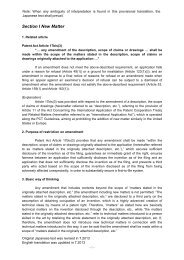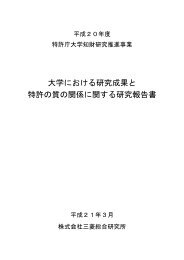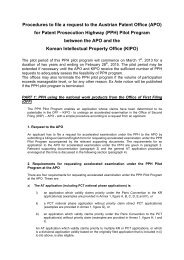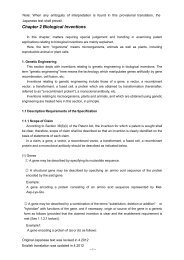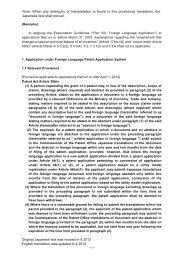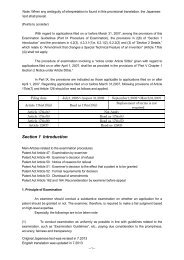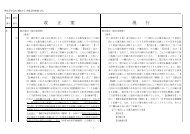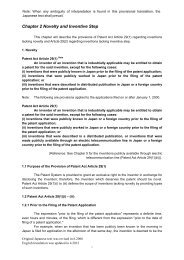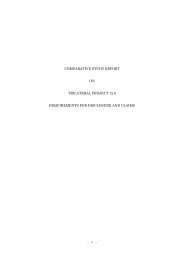Requirements for Unity of Application - Japan Patent Office
Requirements for Unity of Application - Japan Patent Office
Requirements for Unity of Application - Japan Patent Office
Create successful ePaper yourself
Turn your PDF publications into a flip-book with our unique Google optimized e-Paper software.
[Example 37]<br />
[Title <strong>of</strong> the Invention]<br />
Process <strong>for</strong> determination <strong>of</strong> the running speed <strong>of</strong> thread and estimating the number <strong>of</strong><br />
false-twists in false-twisting machine<br />
[Claims]<br />
1. Means <strong>for</strong> measuring the running speed <strong>of</strong> the tread (Y) by running said thread (Y)<br />
through two capacitance type detector heads (1a, 1b) spaced at specified distance L,<br />
through L/T operations <strong>of</strong> the time <strong>for</strong> the twist to pass through one head and arrive at the<br />
second. (See Figure 1)<br />
2. Means <strong>of</strong> obtaining the running speed <strong>of</strong> the thread Y, and based on the this in<strong>for</strong>mation,<br />
to estimate the false-twisting number <strong>of</strong> the thread Y, as the thread runs through the two<br />
capacitance type detector heads (1a, 1b) spaced at a specific distance L, while being<br />
twined, and the time T required <strong>for</strong> the twist <strong>of</strong> thread Y detected at one head and until it<br />
reaches the second is processed through L/T operation.<br />
[Excerpt from Detail Description <strong>of</strong> the Invention and Drawings]<br />
This invention concerns the detection <strong>of</strong> the funning speed <strong>of</strong> the thread without physical<br />
contact with the thread itself. Applying the specified process on false-twisting machine and<br />
measuring the running speed <strong>of</strong> the thread in false-twisting stage, enables estimation <strong>of</strong> the<br />
number <strong>of</strong> false-twists in the running thread Y. The usual process <strong>of</strong> measuring the running<br />
speed <strong>of</strong> the thread is by contact with a roller and obtaining the number <strong>of</strong> its spin, but this<br />
processesometime affected the running <strong>of</strong> the thread or caused the thread to break.<br />
Figure 1<br />
[Explanation]<br />
The technical fields <strong>of</strong> the specified invention (Claim 1) and related invention (Claim 2) are<br />
in “the measurement <strong>of</strong> the running speed <strong>of</strong> the thread” and “estimation <strong>of</strong> false-twists in the<br />
thread", respectively. The measured running speed <strong>of</strong> the thread, however, is used to estimate<br />
the number <strong>of</strong> false-twists in a thread, the two inventions are technically and directly related,<br />
and the industrial fields <strong>of</strong> application <strong>of</strong> both inventions are the same.<br />
The substantial part <strong>of</strong> the measurement <strong>of</strong> the running speed <strong>of</strong> the thread that is the<br />
new matter corresponding to the problem to be solved <strong>of</strong> the specified invention (Claim 1) is<br />
substantial part <strong>of</strong> matters in the claim <strong>of</strong> the related invention (Claim 2). There<strong>for</strong>e the<br />
substantial parts <strong>of</strong> matters in the claims <strong>of</strong> the inventions are the same.<br />
[Concerned Section]<br />
<strong>Patent</strong> Law Section 37(ii)<br />
71



